Validation of Global Moderate-Resolution FAPAR Products over Boreal Forests in North America Using Harmonized Landsat and Sentinel-2 Data
Abstract
1. Introduction
2. Study Area and Data
2.1. Study Area and In Situ Data
2.2. Moderate-Resolution FAPAR Products
2.2.1. MODIS and VIIRS FAPAR Products
2.2.2. CGLS FAPAR Products
2.3. The Harmonized Landsat and Sentinel-2 (HLS) Imagery
3. Method
3.1. Derivation of High-Resolution FAPAR from HLS
3.2. Evaluation and Validation of FAPAR Products
4. Results
4.1. High-Resolution Instantaneous FAPAR
4.2. Product Quality Control Information
4.3. Validation of FAPAR Products
5. Discussion
5.1. FAPAR Product Quality
5.2. Uncertainties and Perspectives
6. Conclusions
Supplementary Materials
Author Contributions
Funding
Data Availability Statement
Acknowledgments
Conflicts of Interest
References
- Zhang, Y.; Hu, Z.; Fang, H.; Gao, X.; Wang, J.; Wu, G. Estimation of daily FAPAR from MODIS instantaneous observations at forest sites. Agric. For. Meteorol. 2023, 331, 109336. [Google Scholar] [CrossRef]
- Pilaš, I.; Medved, I.; Medak, J.; Medak, D. Response strategies of the main forest types to climatic anomalies across Croatian biogeographic regions inferred from FAPAR remote sensing data. For. Ecol. Manag. 2014, 326, 58–78. [Google Scholar] [CrossRef]
- World Meteorological Organization. The Global Observing System for Climate Implementation Needs; GCOS: Geneva, Switzerland, 2022; p. 316. [Google Scholar]
- Knyazikhin, Y.; Martonchik, J.V.; Myneni, R.B.; Diner, D.J.; Running, S.W. Synergistic algorithm for estimating vegetation canopy leaf area index and fraction of absorbed photosynthetically active radiation from MODIS and MISR data. J. Geophys. Res. Atmos. 1998, 103, 32257–32275. [Google Scholar] [CrossRef]
- Yan, K.; Park, T.; Chen, C.; Xu, B.; Song, W.; Yang, B.; Zeng, Y.; Liu, Z.; Yan, G.; Knyazikhin, Y.; et al. Generating Global Products of LAI and FPAR From SNPP-VIIRS Data: Theoretical Background and Implementation. IEEE Trans. Geosci. Remote Sens. 2018, 56, 2119–2137. [Google Scholar] [CrossRef]
- Verger, A.; Baret, F.; Weiss, M. Near Real-Time Vegetation Monitoring at Global Scale. IEEE J. Sel. Top. Appl. Earth Obs. Remote Sens. 2014, 7, 3473–3481. [Google Scholar] [CrossRef]
- Zhang, Z.; Zhang, Y.; Zhang, Y.; Gobron, N.; Frankenberg, C.; Wang, S.; Li, Z. The potential of satellite FPAR product for GPP estimation: An indirect evaluation using solar-induced chlorophyll fluorescence. Remote Sens. Environ. 2020, 240, 111686. [Google Scholar] [CrossRef]
- Tao, X.; Liang, S.; Wang, D. Assessment of five global satellite products of fraction of absorbed photosynthetically active radiation: Intercomparison and direct validation against ground-based data. Remote Sens. Environ. 2015, 163, 270–285. [Google Scholar] [CrossRef]
- Zhang, Y.; Hu, Z.; Wang, J.; Gao, X.; Yang, C.; Yang, F.; Wu, G. Temporal upscaling of MODIS instantaneous FAPAR improves forest gross primary productivity (GPP) simulation. Int. J. Appl. Earth Obs. Geoinf. 2023, 121, 103360. [Google Scholar] [CrossRef]
- Fang, H.L.; Baret, F.; Plummer, S.; Schaepman-Strub, G. An Overview of Global Leaf Area Index (LAI): Methods, Products, Validation, and Applications. Rev. Geophys. 2019, 57, 739–799. [Google Scholar] [CrossRef]
- Yan, K.; Park, T.; Yan, G.J.; Liu, Z.; Yang, B.; Chen, C.; Nemani, R.R.; Knyazikhin, Y.; Myneni, R.B. Evaluation of MODIS LAI/FPAR Product Collection 6. Part 2: Validation and Intercomparison. Remote Sens. 2016, 8, 460. [Google Scholar] [CrossRef]
- Akitsu, T.K.; Nasahara, K.N. In-situ observations on a moderate resolution scale for validation of the Global Change Observation Mission-Climate ecological products: The uncertainty quantification in ecological reference data. Int. J. Appl. Earth Obs. Geoinf. 2022, 107, 102639. [Google Scholar] [CrossRef]
- Brown, L.A.; Meier, C.; Morris, H.; Pastor-Guzman, J.; Bai, G.; Lerebourg, C.; Gobron, N.; Lanconelli, C.; Clerici, M.; Dash, J. Evaluation of global leaf area index and fraction of absorbed photosynthetically active radiation products over North America using Copernicus Ground Based Observations for Validation data. Remote Sens. Environ. 2020, 247, 111935. [Google Scholar] [CrossRef]
- Fang, H.; Zhang, Y.; Wei, S.; Li, W.; Ye, Y.; Sun, T.; Liu, W. Validation of global moderate resolution leaf area index (LAI) products over croplands in northeastern China. Remote Sens. Environ. 2019, 233, 111377. [Google Scholar] [CrossRef]
- Xiao, Z.Q.; Liang, S.L.; Sun, R. Evaluation of Three Long Time Series for Global Fraction of Absorbed Photosynthetically Active Radiation (FAPAR) Products. IEEE Trans. Geosci. Remote Sens. 2018, 56, 5509–5524. [Google Scholar] [CrossRef]
- Fuster, B.; Sánchez-Zapero, J.; Camacho, F.; García-Santos, V.; Verger, A.; Lacaze, R.; Weiss, M.; Baret, F.; Smets, B. Quality Assessment of PROBA-V LAI, fAPAR and fCOVER Collection 300 m Products of Copernicus Global Land Service. Remote Sens. 2020, 12, 1017. [Google Scholar] [CrossRef]
- Wojnowski, W.; Wei, S.S.; Li, W.J.; Yin, T.G.; Li, X.X.; Ow, G.L.F.; Yusof, M.L.M.; Whittle, A.J. Comparison of Absorbed and Intercepted Fractions of PAR for Individual Trees Based on Radiative Transfer Model Simulations. Remote Sens. 2021, 13, 1069. [Google Scholar] [CrossRef]
- Trishchenko, A.P.; Cihlar, J.; Li, Z. Effects of spectral response function on surface reflectance and NDVI measured with moderate resolution satellite sensors. Remote Sens. Environ. 2002, 81, 1–18. [Google Scholar] [CrossRef]
- Claverie, M.; Ju, J.; Masek, J.G.; Dungan, J.L.; Vermote, E.F.; Roger, J.C.; Skakun, S.V.; Justice, C. The Harmonized Landsat and Sentinel-2 surface reflectance data set. Remote Sens. Environ. 2018, 219, 145–161. [Google Scholar] [CrossRef]
- Sánchez-Zapero, J.; Pérez, L.; Fuster, B. Copernicus Global Land Operations “Vegetation and Energy” “CGLOPS-1” Scientific Quality Evaluation: LAI, FAPAR FCOVER Collection 300m Version 1; Copernicus: New York, NY, USA, 2018; pp. 1–76. [Google Scholar]
- Fang, H.; Wang, Y.; Zhang, Y.; Li, S. Long-Term Variation of Global GEOV2 and MODIS Leaf Area Index (LAI) and Their Uncertainties: An Insight into the Product Stabilities. J. Remote Sens. 2021, 2021, 9842830. [Google Scholar] [CrossRef]
- Chen, C.; Park, T.; Wang, X.; Piao, S.; Xu, B.; Chaturvedi, R.K.; Fuchs, R.; Brovkin, V.; Ciais, P.; Fensholt, R.; et al. China and India lead in greening of the world through land-use management. Nat Sustain 2019, 2, 122–129. [Google Scholar] [CrossRef]
- Bolton, D.K.; Gray, J.M.; Melaas, E.K.; Moon, M.; Eklundh, L.; Friedl, M.A. Continental-scale land surface phenology from harmonized Landsat 8 and Sentinel-2 imagery. Remote Sens. Environ. 2020, 240, 111685. [Google Scholar] [CrossRef]
- Hynes, A.; Hamann, A. Moisture deficits limit growth of white spruce in the west-central boreal forest of North America. For. Ecol. Manag. 2020, 461, 117944. [Google Scholar] [CrossRef]
- Beamesderfer, E.R.; Arain, M.A.; Khomik, M.; Brodeur, J.J. The Impact of Seasonal and Annual Climate Variations on the Carbon Uptake Capacity of a Deciduous Forest Within the Great Lakes Region of Canada. J Geophys Res Biogeosci 2020, 125, e2019JG005389. [Google Scholar] [CrossRef]
- Jenkins, J.P.; Richardson, A.D.; Braswell, B.H.; Ollinger, S.V.; Hollinger, D.Y.; Smith, M.L. Refining light-use efficiency calculations for a deciduous forest canopy using simultaneous tower-based carbon flux and radiometric measurements. Agric. For. Meteorol. 2007, 143, 64–79. [Google Scholar] [CrossRef]
- Pilegaard, K.; Ibrom, A.; Courtney, M.S.; Hummelshøj, P.; Jensen, N.O. Increasing net CO2 uptake by a Danish beech forest during the period from 1996 to 2009. Agric. For. Meteorol. 2011, 151, 934–946. [Google Scholar] [CrossRef]
- Rogers, C.; Chen, J.M.; Croft, H.; Gonsamo, A.; Luo, X.; Bartlett, P.; Staebler, R.M. Daily leaf area index from photosynthetically active radiation for long term records of canopy structure and leaf phenology. Agric. For. Meteorol. 2021, 304-305, 108407. [Google Scholar] [CrossRef]
- Myneni, R. MODIS Collection 6 (C6) LAI/FPAR Product User’s Guide; NASA: Greenbelt, MD, USA, 2015; p. 13.
- Myneni, R.B.; Ramakrishna, R.; Nemani, R.; Running, S.W. Estimation of global leaf area index and absorbed par using radiative transfer models. IEEE Trans. Geosci. Remote Sens. 1997, 35, 1380–1393. [Google Scholar] [CrossRef]
- Pickett-Heaps, C.A.; Canadell, J.G.; Briggs, P.R.; Gobron, N.; Haverd, V.; Paget, M.J.; Pinty, B.; Raupach, M.R. Evaluation of six satellite-derived Fraction of Absorbed Photosynthetic Active Radiation (FAPAR) products across the Australian continent. Remote Sens. Environ. 2014, 140, 241–256. [Google Scholar] [CrossRef]
- Dierckx, W.; Sterckx, S.; Benhadj, I.; Livens, S.; Duhoux, G.; Van Achteren, T.; Francois, M.; Mellab, K.; Saint, G. PROBA-V mission for global vegetation monitoring: Standard products and image quality. Int. J. Remote Sens. 2014, 35, 2589–2614. [Google Scholar] [CrossRef]
- Baret, F.; Weiss, M.; Lacaze, R.; Camacho, F.; Makhmara, H.; Pacholcyzk, P.; Smets, B. GEOV1: LAI and FAPAR essential climate variables and FCOVER global time series capitalizing over existing products. Part1: Principles of development and production. Remote Sens. Environ. 2013, 137, 299–309. [Google Scholar] [CrossRef]
- Verger, A.; Sánchez-Zapero, J.; Weiss, M.; Descals, A.; Camacho, F.; Lacaze, R.; Baret, F. GEOV2: Improved smoothed and gap filled time series of LAI, FAPAR and FCover 1 km Copernicus Global Land products. Int. J. Appl. Earth Obs. Geoinf. 2023, 123, 103479. [Google Scholar] [CrossRef]
- Morisette, J.T.; Baret, F.; Privette, J.L.; Myneni, R.B.; Nickeson, J.E.; Garrigues, S.; Shabanov, N.V.; Weiss, M.; Fernandes, R.A.; Leblanc, S.G.; et al. Validation of global moderate-resolution LAI products:: A framework proposed within the CEOS Land Product Validation subgroup. IEEE Trans. Geosci. Remote Sens. 2006, 44, 1804–1817. [Google Scholar] [CrossRef]
- Li, S.; Fang, H.; Zhang, Y.; Wang, Y. Comprehensive evaluation of global CI, FVC, and LAI products and their relationships using high-resolution reference data. Sci. Remote Sens. 2022, 6, 100066. [Google Scholar] [CrossRef]
- Jacquemoud, S.; Verhoef, W.; Baret, F.; Bacour, C.; Zarco-Tejada, P.J.; Asner, G.P.; François, C.; Ustin, S.L. PROSPECT+SAIL models: A review of use for vegetation characterization. Remote Sens. Environ. 2009, 113, S56–S66. [Google Scholar] [CrossRef]
- Zhang, Y.; Fang, H.; Wang, Y.; Li, S. Variation of intra-daily instantaneous FAPAR estimated from the geostationary Himawari-8 AHI data. Agric. For. Meteorol. 2021, 307, 108535. [Google Scholar] [CrossRef]
- Li, W.J.; Weiss, M.; Garric, B.; Champolivier, L.; Jiang, J.Y.; Wu, W.B.; Baret, F. Mapping Crop Leaf Area Index and Canopy Chlorophyll Content Using UAV Multispectral Imagery: Impacts of Illuminations and Distribution of Input Variables. Remote Sens. 2023, 15, 1539. [Google Scholar] [CrossRef]
- Hussain, N.; Gonsamo, A.; Wang, S.; Arain, M.A. Assessment of spongy moth infestation impacts on forest productivity and carbon loss using the Sentinel-2 satellite remote sensing and eddy covariance flux data. Ecol. Process 2024, 13, 37. [Google Scholar] [CrossRef] [PubMed]
- Zhang, Q.; Xiao, X.; Braswell, B.; Linder, E.; Ollinger, S.; Smith, M.-L.; Jenkins, J.P.; Baret, F.; Richardson, A.D.; Moore, B.; et al. Characterization of seasonal variation of forest canopy in a temperate deciduous broadleaf forest, using daily MODIS data. Remote Sens. Environ. 2006, 105, 189–203. [Google Scholar] [CrossRef]
- Sinha, S.K.; Padalia, H.; Dasgupta, A.; Verrelst, J.; Rivera, J.P. Estimation of leaf area index using PROSAIL based LUT inversion, MLRA-GPR and empirical models: Case study of tropical deciduous forest plantation, North India. Int. J. Appl. Earth Obs. Geoinf. 2020, 86, 102027. [Google Scholar] [CrossRef]
- Féret, J.B.; Gitelson, A.A.; Noble, S.D.; Jacquemoud, S. PROSPECT-D: Towards modeling leaf optical properties through a complete lifecycle. Remote Sens. Environ. 2017, 193, 204–215. [Google Scholar] [CrossRef]
- Majasalmi, T.; Rautiainen, M.; Stenberg, P. Modeled and measured fPAR in a boreal forest: Validation and application of a new model. Agric. For. Meteorol. 2014, 189-190, 118–124. [Google Scholar] [CrossRef]
- Gobron, N.; Pinty, B.; Aussedat, O.; Taberner, M.; Faber, O.; Melin, F.; Lavergne, T.; Robustelli, M.; Snoeij, P. Uncertainty estimates for the FAPAR operational products derived from MERIS—Impact of top-of-atmosphere radiance uncertainties and validation with field data. Remote Sens. Environ. 2008, 112, 1871–1883. [Google Scholar] [CrossRef]
- Ouimette, A.P.; Ollinger, S.V.; Richardson, A.D.; Hollinger, D.Y.; Keenan, T.F.; Lepine, L.C.; Vadeboncoeur, M.A. Carbon fluxes and interannual drivers in a temperate forest ecosystem assessed through comparison of top-down and bottom-up approaches. Agric. For. Meteorol. 2018, 256, 420–430. [Google Scholar] [CrossRef]
- Ma, H.; Liang, S. Development of the GLASS 250-m leaf area index product (version 6) from MODIS data using the bidirectional LSTM deep learning model. Remote Sens. Environ. 2022, 273, 112985. [Google Scholar] [CrossRef]
- Munier, S.; Carrer, D.; Planque, C.; Camacho, F.; Albergel, C.; Calvet, J.C. Satellite Leaf Area Index: Global Scale Analysis of the Tendencies Per Vegetation Type Over the Last 17 Years. Remote Sens. 2018, 10, 424. [Google Scholar] [CrossRef]
- Yan, K.; Zhang, X.; Peng, R.; Gao, S.; Liu, J. The Impact of Quality Control Methods on Vegetation Monitoring Using MODIS FPAR Time Series. Forests 2024, 15, 553. [Google Scholar] [CrossRef]
- Fang, H.; Li, W.; Myneni, R.B. The Impact of Potential Land Cover Misclassification on MODIS Leaf Area Index (LAI) Estimation: A Statistical Perspective. Remote Sens. 2013, 5, 830–844. [Google Scholar] [CrossRef]
- Myneni, R.B.; Hoffman, S.; Knyazikhin, Y.; Privette, J.L.; Glassy, J.; Tian, Y.; Wang, Y.; Song, X.; Zhang, Y.; Smith, G.R.; et al. Global products of vegetation leaf area and fraction absorbed PAR from year one of MODIS data. Remote Sens. Environ. 2002, 83, 214–231. [Google Scholar] [CrossRef]
- Camacho, F.; Cernicharo, J.; Lacaze, R.; Baret, F.; Weiss, M. GEOV1: LAI, FAPAR essential climate variables and FCOVER global time series capitalizing over existing products. Part 2: Validation and intercomparison with reference products. Remote Sens. Environ. 2013, 137, 310–329. [Google Scholar] [CrossRef]
- Arain, M.A. AmeriFlux BASE CA-TP4 Ontario—Turkey Point 1939 Plantation White Pine. 2018. Available online: https://ameriflux.lbl.gov/sites/siteinfo/CA-TP4 (accessed on 27 July 2025).
- Sulla-Menashe, D.; Friedl, M.A. User Guide to Collection 6 MODIS Land Cover (MCD12Q1 and MCD12C1) Product; NASA: Greenbelt, MD, USA, 2018. [CrossRef]
- Harper, K.L.; Lamarche, C.; Hartley, A.; Peylin, P.; Ottlé, C.; Bastrikov, V.; San Martín, R.; Bohnenstengel, S.I.; Kirches, G.; Boettcher, M.; et al. A 29-year time series of annual 300 m resolution plant-functional-type maps for climate models. Earth Syst. Sci. Data 2023, 15, 1465–1499. [Google Scholar] [CrossRef]
- Camacho, F.; Fuster, B.; Li, W.; Weiss, M.; Ganguly, S.; Lacaze, R.; Baret, F. Crop specific algorithms trained over ground measurements provide the best performance for GAI and fAPAR estimates from Landsat-8 observations. Remote Sens. Environ. 2021, 260, 112453. [Google Scholar] [CrossRef]
- Bayat, B.; Camacho, F.; Nickeson, J.; Cosh, M.; Bolten, J.; Vereecken, H.; Montzka, C. Toward operational validation systems for global satellite-based terrestrial essential climate variables. Int. J. Appl. Earth Obs. Geoinf. 2021, 95, 102240. [Google Scholar] [CrossRef]
- Wang, M.; Zheng, Y.; Huang, C.; Meng, R.; Pang, Y.; Jia, W.; Zhou, J.; Huang, Z.; Fang, L.; Zhao, F. Assessing Landsat-8 and Sentinel-2 spectral-temporal features for mapping tree species of northern plantation forests in Heilongjiang Province, China. For. Ecosyst. 2022, 9, 100032. [Google Scholar] [CrossRef]
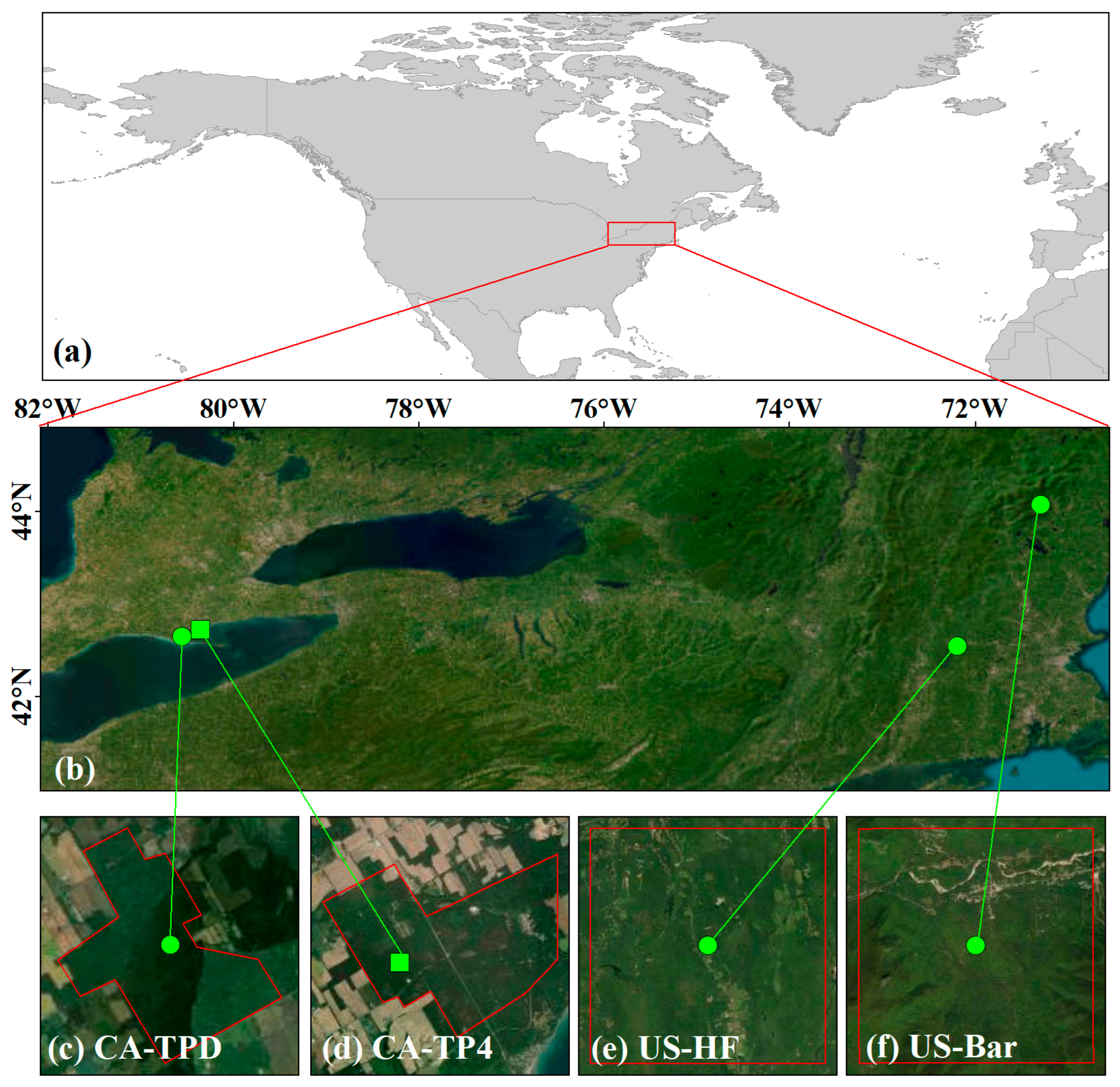

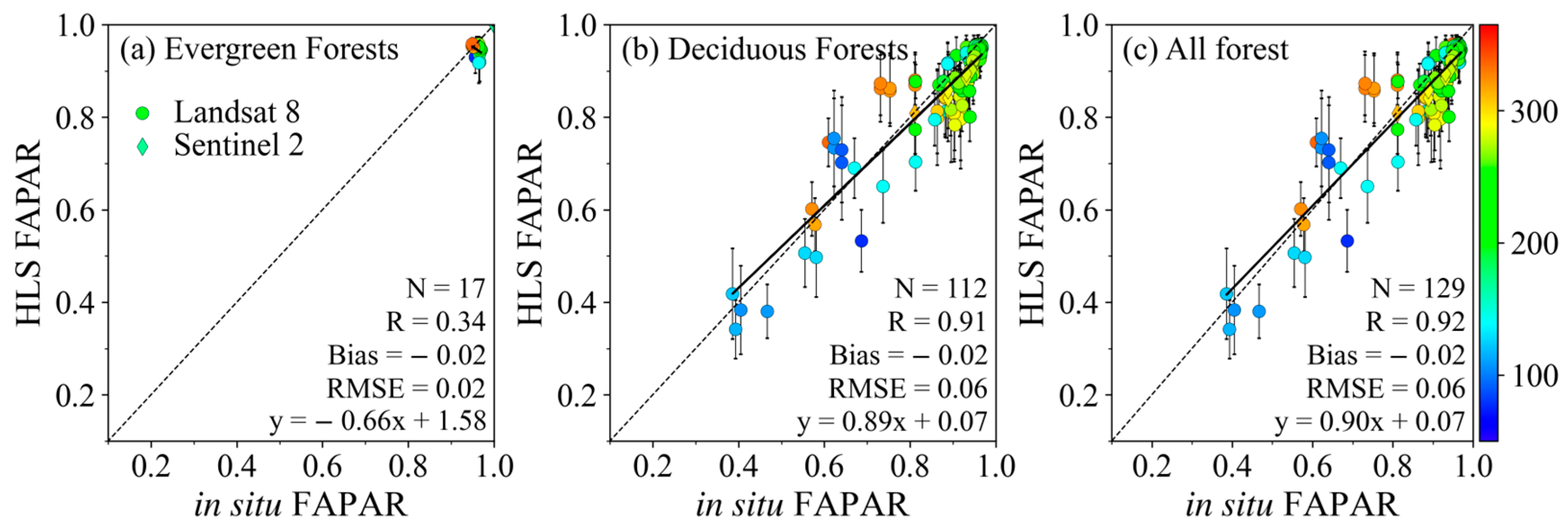


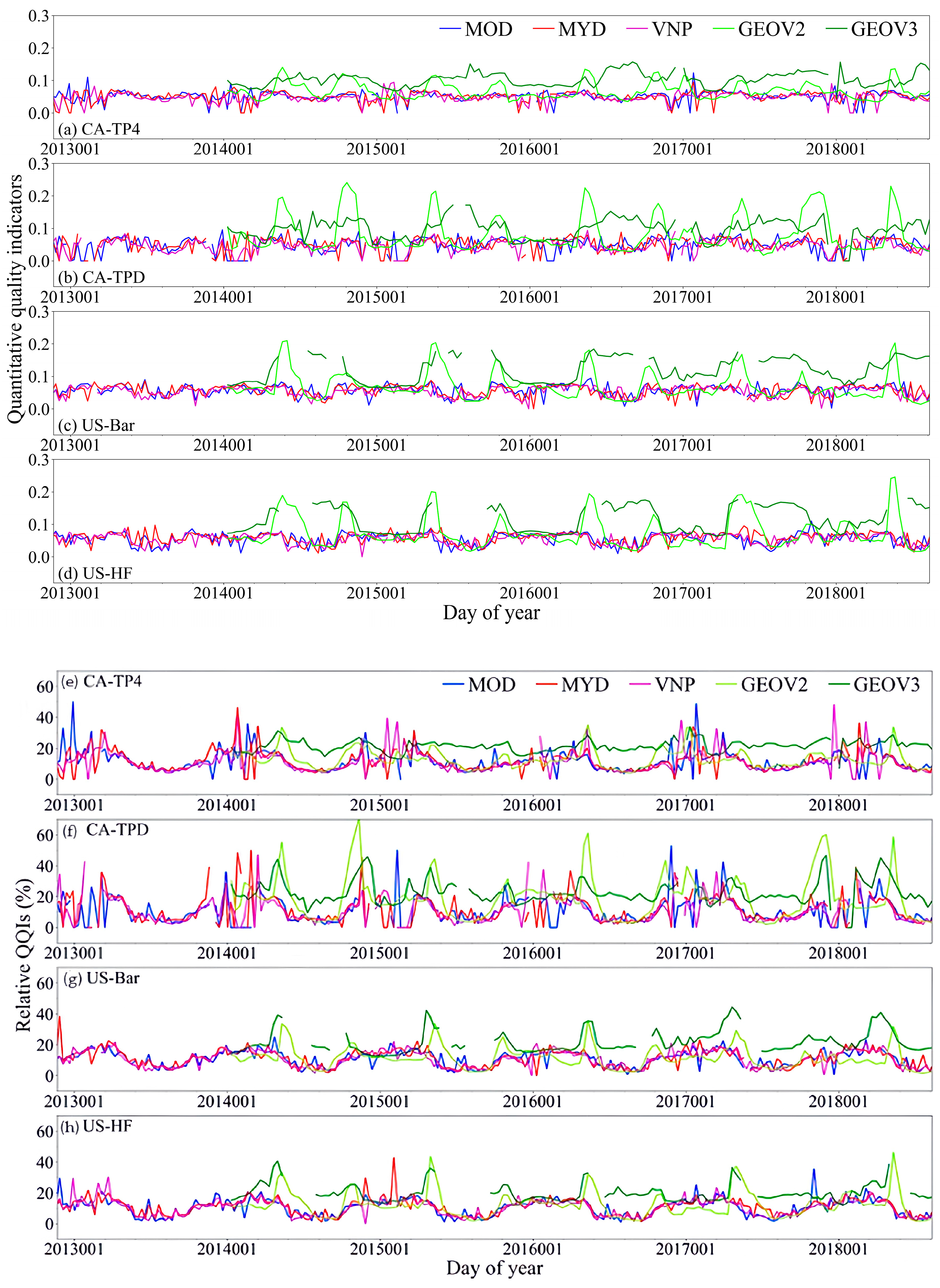
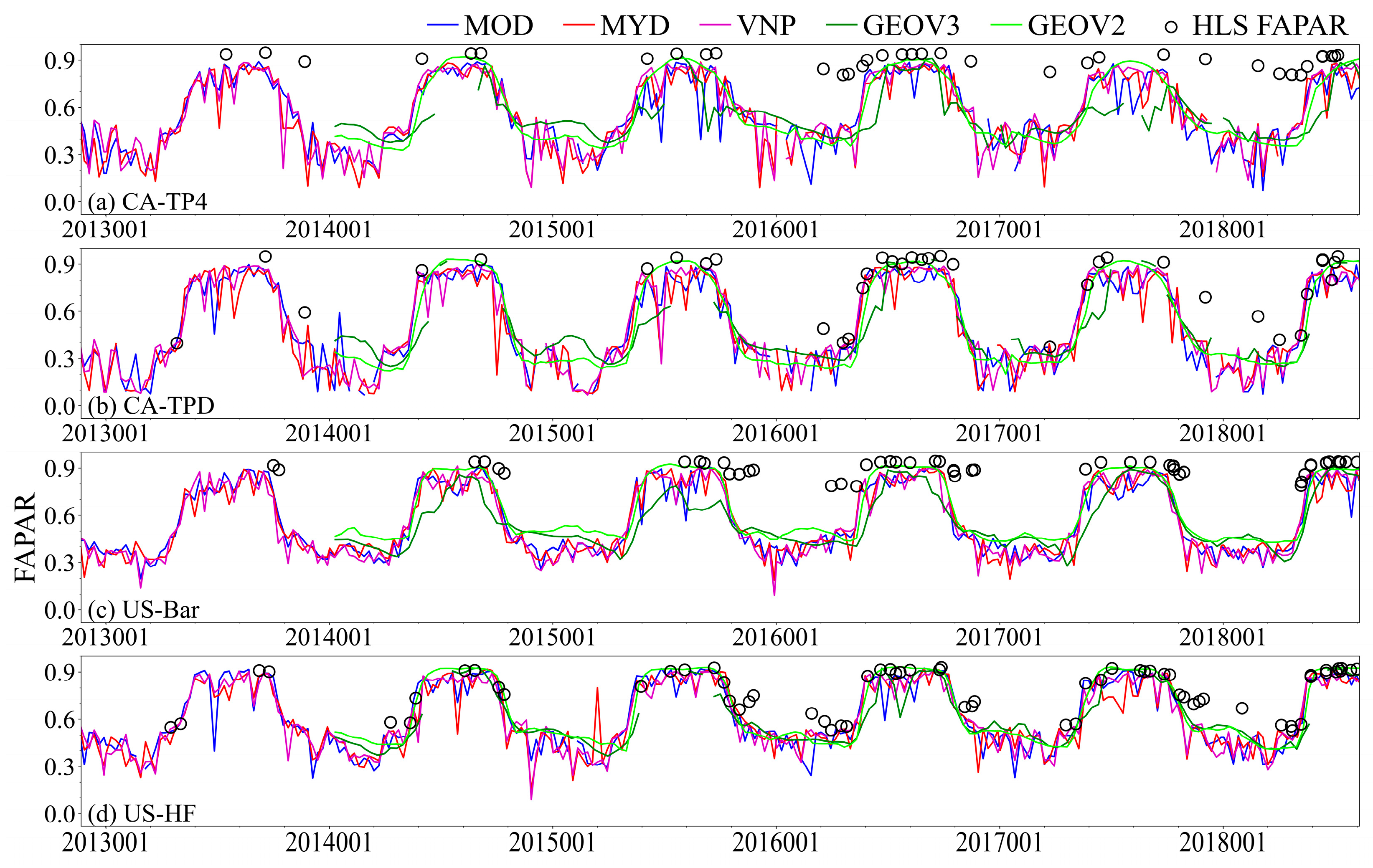
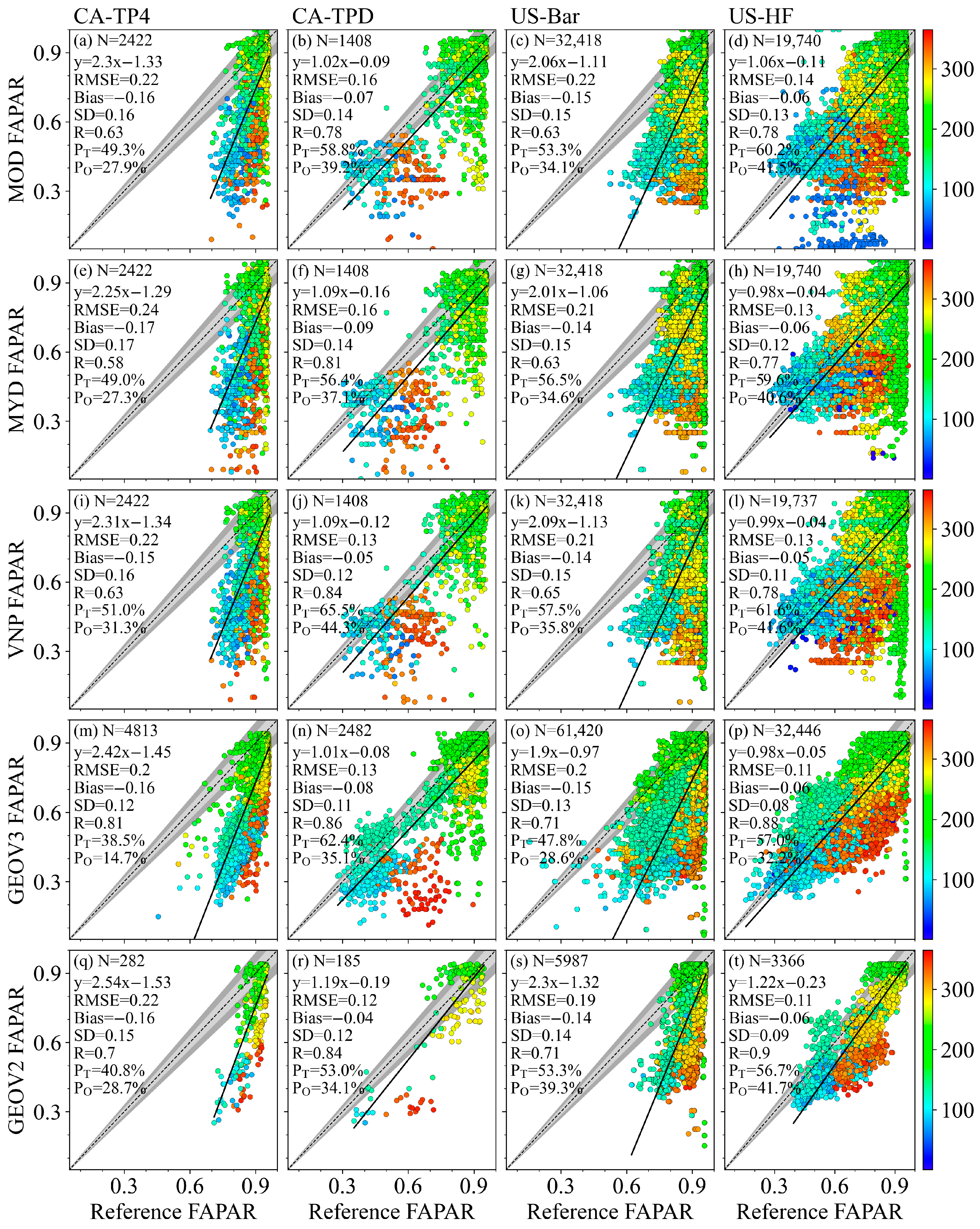

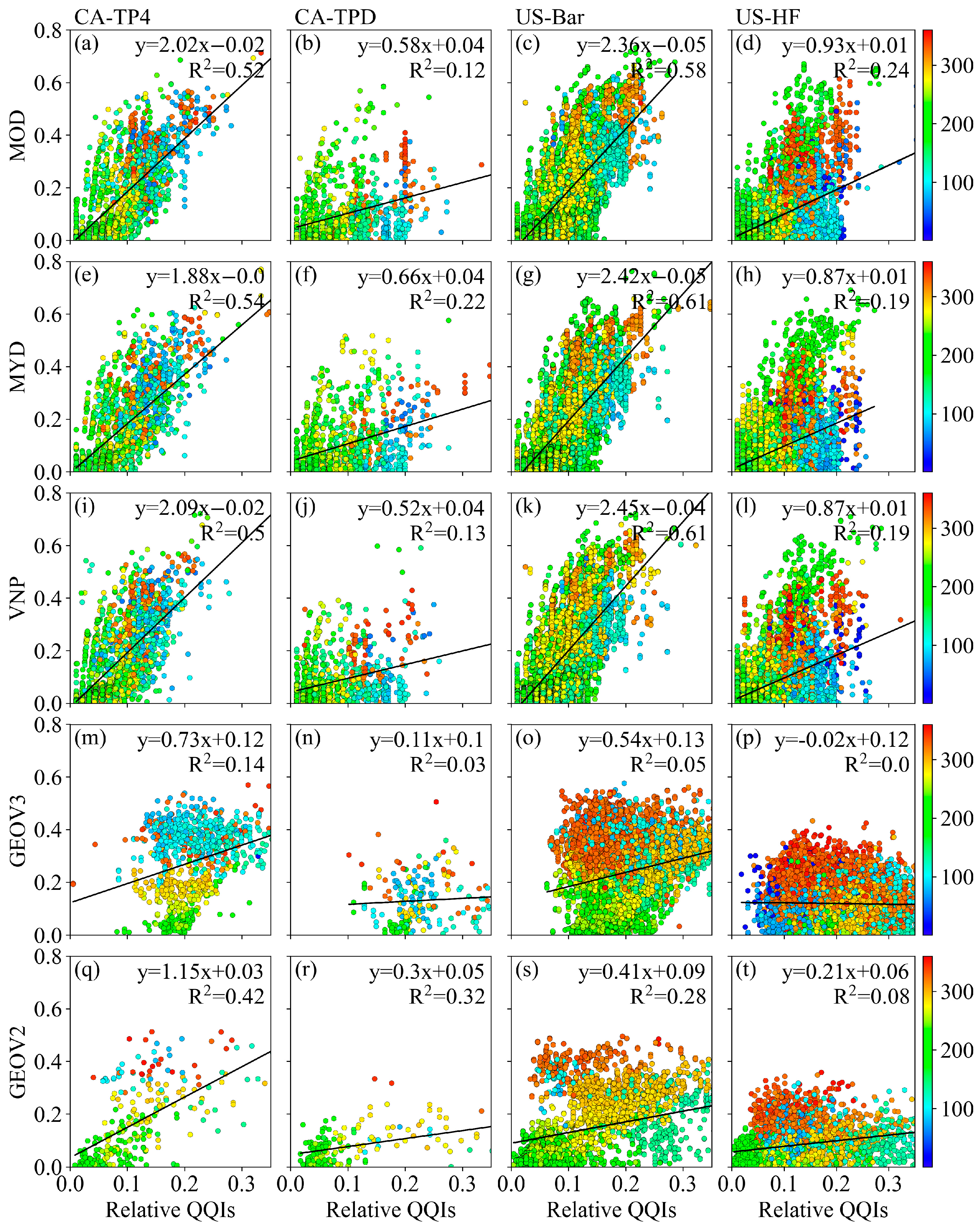
| Site ID | Names | Type | Latitude | Longitude | Duration | Elevation |
|---|---|---|---|---|---|---|
| CA–TP4 | Ontario-Turkey Point 1939 Plantation White Pine | Evergreen Forest | 42.7102 | −80.3574 | 2013/12/2–2017/7/14 | 184 m |
| CA–TPD | Ontario-Turkey Point Mature Deciduous | Deciduous Forest | 42.6353 | −80.5577 | 2012/1/5–2017/12/31 | 260 m |
| US–Bar | Bartlett Experimental Forest | Deciduous Forest | 44.0646 | −71.2881 | 2004/6/10–2017/12/31 | 272 m |
| US–HF | Harvard Forest | Deciduous Forest | 42.5353 | −72.1899 | 2011/11/23–2015/8/14 | 351 m |
| Product | Sensor | Spatial Resolution | Temporal Resolution | Period | Main Algorithm | Back Up Algorithm | QQFs |
|---|---|---|---|---|---|---|---|
| MOD15A2H.061 | MODIS | 500 m | 8-day | 2002+ | LUT (red, NIR) | VI (red, NIR) | (1) Main method with best result (2) Main method with good result (saturation) (3) Empirical algorithm used due to bad geometry (4) Empirical algorithm used due to problems other than geometry |
| MYD15A2H.061 | |||||||
| VNP15A2H v002 | VIIRS | 500 m | 8-day | 2012+ | |||
| GEOV2 | PROBA-V | 1 km | 10-day | 1999+ | NN (blue, red, NIR, observation geometry) | Filled with interpolation or climatology | (1) Direct retrieve (not filled) (2) Filled with interpolation (3) Filled with climatology |
| GEOV3 | PROBA-V | 1/3 km | 10-day | 2014+ | EBF: NN (blue, red, NIR, observation geometry) Others: Second-degree polynomials fit of the NN result | EBF: Based on previous decadal product Others: Filled by linear fit or nearest data | EBF (1) Based on daily observations (2) Based on previous dekadal product Others: (3) Second-degree polynomials fit (4) Linear fit (5) Interpolation between the two nearest dates within days (6) Nearest data within days |
| Parameter | CA-TP4 | CA-TPD/US-HF | US-Bar | ||||
|---|---|---|---|---|---|---|---|
| Min | Max | Min | Max | Min | Max | ||
| Canopy structure | Leaf area index | 0 | 8 | 0 | 7 | 0 | 10 |
| Leaf structure parameter | 0.5 | 2.75 | 0.5 | 2.75 | 0.5 | 2.75 | |
| Average leaf angle (◦) | 30 | 80 | 10 | 50 | 40 | 80 | |
| Leaf property | Chlorophyll A and B (g/cm2) | 10 | 60 | 50 | 80 | 10 | 50 |
| Equivalent water thickness (cm) | 0 | 0.2 | 0 | 0.1 | 0 | 0.5 | |
| Dry matter content (g/cm2) | 0 | 0.2 | 0 | 0.1 | 0 | 0.2 | |
| Soil reflectance coefficient | 0.3 | 1 | 0.3 | 1 | 0.3 | 1 | |
| Diffuse fraction | 0.01 | 0.6 | 0.01 | 0.6 | 0.01 | 0.6 | |
| Metrics | Explanation | Interpretation | |
|---|---|---|---|
| RMSE | Overall uncertainty | (2) | |
| Bias | Accuracy | (3) | |
| SD | Precision | (4) | |
| R | Strength of relationship between two variables | (5) | |
| P | Percentage of pixels meeting requirements | PO: Percentage of pixels meeting the optimal requirements of the CGLS and the goal requirements of the GCOS PT: Percentage of pixels meeting the target requirements of the CGLS and the threshold requirements of the GCOS | |
| Sites | Products | Pixel-Level Comparison | Plot-Level Comparison | ||||||||||
|---|---|---|---|---|---|---|---|---|---|---|---|---|---|
| R | RMSE | Bias | SD | PO (%) | PT (%) | R | RMSE | Bias | SD | PO (%) | PT (%) | ||
| (a) CA-TP4 | MOD | 0.63 | 0.22 | −0.16 | 0.16 | 27.91 | 49.30 | 0.85 | 0.21 | −0.16 | 0.12 | 16.84 | 42.11 |
| MYD | 0.58 | 0.24 | −0.17 | 0.17 | 27.29 | 49.01 | 0.75 | 0.24 | −0.19 | 0.15 | 10.53 | 38.95 | |
| VNP | 0.63 | 0.22 | −0.15 | 0.16 | 31.30 | 50.99 | 0.84 | 0.21 | −0.17 | 0.13 | 9.47 | 46.32 | |
| GEOV2 | 0.70 | 0.22 | −0.16 | 0.15 | 28.72 | 40.78 | 0.85 | 0.21 | −0.17 | 0.12 | 1.47 | 30.88 | |
| GEOV3 | 0.81 | 0.20 | −0.16 | 0.12 | 14.71 | 38.48 | 0.74 | 0.22 | −0.17 | 0.14 | 24.53 | 41.51 | |
| (b) CA-TPD | MOD | 0.78 | 0.16 | −0.07 | 0.14 | 39.20 | 58.81 | 0.89 | 0.12 | −0.07 | 0.1 | 34.48 | 59.77 |
| MYD | 0.81 | 0.16 | −0.09 | 0.14 | 37.14 | 56.39 | 0.89 | 0.14 | −0.08 | 0.11 | 32.18 | 57.47 | |
| VNP | 0.84 | 0.13 | −0.05 | 0.12 | 44.32 | 65.48 | 0.93 | 0.1 | −0.05 | 0.09 | 52.87 | 74.71 | |
| GEOV2 | 0.84 | 0.12 | −0.04 | 0.12 | 34.05 | 52.97 | 0.89 | 0.13 | −0.08 | 0.1 | 33.33 | 58.73 | |
| GEOV3 | 0.86 | 0.13 | −0.08 | 0.11 | 35.09 | 62.41 | 0.91 | 0.12 | −0.06 | 0.11 | 34.78 | 52.17 | |
| (c) US-Bar | MOD | 0.63 | 0.22 | −0.15 | 0.15 | 34.06 | 53.29 | 0.79 | 0.21 | −0.16 | 0.14 | 21.47 | 49.44 |
| MYD | 0.63 | 0.21 | −0.14 | 0.15 | 34.61 | 56.51 | 0.76 | 0.21 | −0.16 | 0.14 | 18.08 | 51.98 | |
| VNP | 0.65 | 0.21 | −0.14 | 0.15 | 35.85 | 57.51 | 0.80 | 0.2 | −0.15 | 0.13 | 20.62 | 54.52 | |
| GEOV2 | 0.71 | 0.19 | −0.14 | 0.14 | 39.25 | 53.35 | 0.75 | 0.21 | −0.17 | 0.13 | 22.14 | 44.66 | |
| GEOV3 | 0.71 | 0.20 | −0.15 | 0.13 | 28.56 | 47.81 | 0.75 | 0.19 | −0.14 | 0.13 | 43.65 | 54.31 | |
| (d) US-HF | MOD | 0.78 | 0.14 | −0.06 | 0.13 | 41.47 | 60.24 | 0.88 | 0.11 | −0.06 | 0.09 | 51.40 | 67.60 |
| MYD | 0.77 | 0.13 | −0.06 | 0.12 | 40.59 | 59.59 | 0.85 | 0.12 | −0.07 | 0.1 | 43.58 | 64.80 | |
| VNP | 0.78 | 0.13 | −0.05 | 0.11 | 41.56 | 61.64 | 0.90 | 0.09 | −0.05 | 0.07 | 52.51 | 70.95 | |
| GEOV2 | 0.90 | 0.11 | −0.06 | 0.09 | 41.68 | 56.74 | 0.92 | 0.09 | −0.06 | 0.07 | 40.60 | 61.65 | |
| GEOV3 | 0.88 | 0.11 | −0.06 | 0.08 | 32.16 | 57.01 | 0.93 | 0.1 | −0.06 | 0.09 | 43.27 | 55.77 | |
| (e) mean | MOD | 0.71 | 0.19 | −0.11 | 0.15 | 35.66 | 55.41 | 0.85 | 0.16 | −0.11 | 0.11 | 31.05 | 54.73 |
| MYD | 0.70 | 0.19 | −0.12 | 0.15 | 34.91 | 55.38 | 0.81 | 0.18 | −0.13 | 0.13 | 26.09 | 53.30 | |
| VNP | 0.73 | 0.17 | −0.10 | 0.14 | 38.25 | 58.90 | 0.87 | 0.15 | −0.11 | 0.11 | 33.87 | 61.62 | |
| GEOV2 | 0.79 | 0.16 | −0.10 | 0.13 | 35.93 | 50.96 | 0.85 | 0.16 | −0.12 | 0.11 | 24.39 | 48.98 | |
| GEOV3 | 0.82 | 0.16 | −0.11 | 0.11 | 27.63 | 51.43 | 0.83 | 0.16 | −0.11 | 0.12 | 36.56 | 50.94 | |
Disclaimer/Publisher’s Note: The statements, opinions and data contained in all publications are solely those of the individual author(s) and contributor(s) and not of MDPI and/or the editor(s). MDPI and/or the editor(s) disclaim responsibility for any injury to people or property resulting from any ideas, methods, instructions or products referred to in the content. |
© 2025 by the authors. Licensee MDPI, Basel, Switzerland. This article is an open access article distributed under the terms and conditions of the Creative Commons Attribution (CC BY) license (https://creativecommons.org/licenses/by/4.0/).
Share and Cite
Zhang, Y.; Fang, H.; Hu, Z.; Wang, Y.; Li, S.; Wu, G. Validation of Global Moderate-Resolution FAPAR Products over Boreal Forests in North America Using Harmonized Landsat and Sentinel-2 Data. Remote Sens. 2025, 17, 2658. https://doi.org/10.3390/rs17152658
Zhang Y, Fang H, Hu Z, Wang Y, Li S, Wu G. Validation of Global Moderate-Resolution FAPAR Products over Boreal Forests in North America Using Harmonized Landsat and Sentinel-2 Data. Remote Sensing. 2025; 17(15):2658. https://doi.org/10.3390/rs17152658
Chicago/Turabian StyleZhang, Yinghui, Hongliang Fang, Zhongwen Hu, Yao Wang, Sijia Li, and Guofeng Wu. 2025. "Validation of Global Moderate-Resolution FAPAR Products over Boreal Forests in North America Using Harmonized Landsat and Sentinel-2 Data" Remote Sensing 17, no. 15: 2658. https://doi.org/10.3390/rs17152658
APA StyleZhang, Y., Fang, H., Hu, Z., Wang, Y., Li, S., & Wu, G. (2025). Validation of Global Moderate-Resolution FAPAR Products over Boreal Forests in North America Using Harmonized Landsat and Sentinel-2 Data. Remote Sensing, 17(15), 2658. https://doi.org/10.3390/rs17152658








